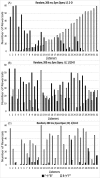Individual listener differences in azimuthal front-back reversals
- PMID: 31671982
- PMCID: PMC6814437
- DOI: 10.1121/1.5129555
Individual listener differences in azimuthal front-back reversals
Abstract
Thirty-two listeners participated in experiments involving five filtered noises when listeners kept their eyes open or closed, for stimuli of short or long duration, and for stimuli that were presented at random locations or in a largely rotational procession. Individual differences in the proportion of front-back reversals (FBRs) were measured. There were strong positive correlations between the proportion of FBRs for any one filtered noise, but not when FBRs were compared across different filtered-noise conditions. The results suggest that, for each individual listener, the rate of FBRs is stable for any one filtered noise, but not across filtered noises.
Figures




Similar articles
-
Randomizing spectral cues used to resolve front-back reversals in sound-source localization.J Acoust Soc Am. 2023 Aug 1;154(2):661-670. doi: 10.1121/10.0020563. J Acoust Soc Am. 2023. PMID: 37540095 Free PMC article.
-
Synchronizing Automatic Gain Control in Bilateral Cochlear Implants Mitigates Dynamic Localization Deficits Introduced by Independent Bilateral Compression.Ear Hear. 2024 Jul-Aug 01;45(4):969-984. doi: 10.1097/AUD.0000000000001492. Epub 2024 Mar 13. Ear Hear. 2024. PMID: 38472134
-
Sound source localization identification accuracy: Level and duration dependencies.J Acoust Soc Am. 2016 Jul;140(1):EL14. doi: 10.1121/1.4954870. J Acoust Soc Am. 2016. PMID: 27475204 Free PMC article.
-
Sound-source localization as a multisystem process: The Wallach azimuth illusion.J Acoust Soc Am. 2019 Jul;146(1):382. doi: 10.1121/1.5116003. J Acoust Soc Am. 2019. PMID: 31370595 Free PMC article.
-
Sound source localization of filtered noises by listeners with normal hearing: a statistical analysis.J Acoust Soc Am. 2013 May;133(5):2876-82. doi: 10.1121/1.4799803. J Acoust Soc Am. 2013. PMID: 23654393 Free PMC article.
Cited by
-
Cones-of-Confusions: Are listeners confused? (L).J Acoust Soc Am. 2023 Nov 1;154(5):2769-2771. doi: 10.1121/10.0022046. J Acoust Soc Am. 2023. PMID: 37916865 Free PMC article.
-
Randomizing spectral cues used to resolve front-back reversals in sound-source localization.J Acoust Soc Am. 2023 Aug 1;154(2):661-670. doi: 10.1121/10.0020563. J Acoust Soc Am. 2023. PMID: 37540095 Free PMC article.
-
Molecular analysis of individual differences in talker search at the cocktail-party.J Acoust Soc Am. 2022 Sep;152(3):1804. doi: 10.1121/10.0014116. J Acoust Soc Am. 2022. PMID: 36182280 Free PMC article.
-
Why Did the Earwitnesses to the John F. Kennedy Assassination Not Agree About the Location of the Gunman?Front Psychol. 2021 Nov 16;12:763432. doi: 10.3389/fpsyg.2021.763432. eCollection 2021. Front Psychol. 2021. PMID: 34867663 Free PMC article. Review.
-
Differential projections from the cochlear nucleus to the inferior colliculus in the mouse.Front Neural Circuits. 2023 Jul 24;17:1229746. doi: 10.3389/fncir.2023.1229746. eCollection 2023. Front Neural Circuits. 2023. PMID: 37554670 Free PMC article.
References
-
- Blauert, J. (1997). Spatial Hearing ( MIT Press, Cambridge, MA: ), 494 pp.
-
- Blauert, J. (1969). “ Sound localization in the median plane,” Acta Acust. Acust. 22, 205–213.
-
- Hebrank, J. , and Wright, D. (1975). “ The effect of stimulus intensity upon the localization of sound sources in the median plane,” J. Sound Vib. 38, 498–500.10.1016/S0022-460X(75)80137-4 - DOI
Publication types
MeSH terms
Grants and funding
LinkOut - more resources
Full Text Sources
Medical

